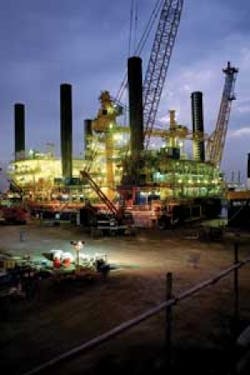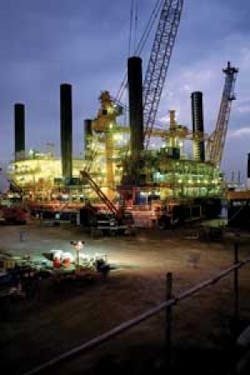Horizontal drilling enables development of complex Al Shaheen field
Martin Naesby
Maersk Oil, Qatar
Maersk Oil’s field development plan for the Al Shaheen field in Qatar has been labeled the most complex offshore development in the region: Fifteen new platforms have been built with the installation of over 140,000 metric tons (154,324 tons) of new facilities in addition to the existing 18 platforms. Over 160 wells have been drilled – including the world’s longest horizontal well ever. Some 230 km (143 mi) of pipeline and 55 km (34 mi) of subsea cables have been laid and about 4 million man hours spent on offshore installation expanding the existing infrastructure.
Maersk Oil, in partnership with Qatar Petroleum, delivered this without a single fatality or serious incident, while increasing production to over 300,000 b/d, reducing gas flaring to a minimum and, at the same time, keeping production uptime at over 99%.
Perfect solution
Oil companies had shunned the Al Shaheen field as commercially unviable for decades. The field was extremely complex. Lying on top of world’s largest gas field, the oil field is characterized by extremely thin layers of rock formation with low permeability.
But to Maersk Oil – in 1992 a smaller independent oil company with production coming primarily from its home country of Denmark – the geological formations appeared very familiar. In fact, the chalk fields in the Danish North Sea are also characterized by tight and generally thin hydrocarbon accumulations.
To extract oil from such reservoirs, Maersk Oil became an expert in horizontal drilling. It was to become a perfect solution for Al Shaheen as the long wells measuring up to 12 km (12.5 mi) made maximum contact with the thin but lengthy reservoirs. And so in 1992 Maersk Oil’s journey began in Qatar with Qatar Petroleum.
By 2005, the field had undergone two development phases and Maersk Oil was gearing up for a far greater third stage. The aims were clear – to optimize the field and raise production by drilling producing and water injection wells and installing a specified number of new build platforms, facilities and pipelines.
But the complexity of the project was underscored by the fact that Maersk Oil and Qatar Petroleum not only wanted to maintain production from the existing facilities during project implementation but they wanted to do this while installing new facilities and maintaining a production uptime above 99% whilst gradually increasing output from the new facilities.
Brownfield developments were mixed with greenfield projects, hundreds of contractor agreements were signed, including multiple Engineering Procurement Installation and Construction (EPIC) contracts with EPIC contractors fabricating simultaneously in UK, India, Abu Dhabi, Malaysia, and Dubai. The schedule of events was dizzying.
Two recent events show in greater detail how Maersk Oil succeeded in delivering this project on time and on budget. The examples show how determination, clarity of objections, frank talks with contractors and a tight hand over budgets and schedules contributed towards success.
Hook-up, commissioning of the G-Location
The installation of the G-Location under the FDP 2005 showcased Maersk Oil’s development of marginal and challenging reservoirs. The project aligned priorities of all the project stakeholders, including the EPIC contractor, from the outset focusing on the timely and safe execution of work.
“The conditions for installation, handover, and offshore start-up of the new facilities were agreed in detail between the Engineering & Projects Group and the Production Department,” said Ervin Pedersen, head of Engineering & Projects, Qatar.
An integrated Maersk Oil site team was deployed to assist the EPIC contractor in achieving the overall schedule, whilst meeting quality and safety targets.
As with previous developments in Al Shaheen, G-Location began producing oil early through the installation of temporary production equipment which generated preliminary cash flow and fed valuable production data into the ongoing drilling program. The location targets oil rims between gas and water in thin reservoirs, where development potential is highly sensitive to the reservoir quality and the geometry of structure or fluid contacts, beyond model resolution.
“Developing marginal reservoirs is a constant learning process where information is processed and used to update predictive 3D reservoir models, identifying alternative opportunities to fine-tune the reservoir development to the actual conditions,” said Esbern Hoch, head of Geoscience, Qatar.
This entailed complex re-planning as the drilling campaign continued. To further optimize well drilling, batch drilling of the individual reservoir sections was introduced. This led to a 30% cost saving on the original drilling campaign.
“Our adaptive approach has meant that 85% of the G-Location development was safeguarded under optimal reservoir conditions and 15% was used to push the boundaries of understanding and defining ways to develop the reservoirs.”
The complexity of simultaneous operations at G-Location posed a significant challenge. A made-to-measure approach with safety plans, bridging, and Simultaneous Operations documents and risk analysis ensured that simultaneous production, drilling, construction, and installation activities were carried out safely and continuously.
The Al Shaheen BF accommodation platforms with 178 beds.
G-Location is now fully onstream, including gas compression and gas export which has resulted in minimal flaring below 1 MMcf/d, meeting one of Maersk Oil’s environmental commitments. Oil production from this location has already exceeded a record of over 100,000 b/d.
Making the best of a gas grid shutdown
The excellent partnership between Maersk Oil and Qatar Petroleum was demonstrated in the face of a long-planned gas grid shutdown which affected Maersk Oil’s ability to export gas linked to the oil production during the shutdown period.
QP had scheduled a 30-day shutdown at the North Field Alpha (NFA) gas treatment and handling facility for vital maintenance to ensure the integrity of facilities in Al Shaheen. This effectively closed the field’s only gas export route.
“Typically, operators would plan either a complete shutdown or to increase flaring of the gas they could not export,” said Karsten Jensen, production operations manager.
But instead, Maersk Oil and QP came up with a disingenuous plan.
Back in 2008, Maersk Oil engineers ran an injection test to see whether gas could be stably injected into a well to support the reservoir pressure and oil drainage without negatively affecting neighboring developments. The pilot was successful and the team wanted more tests for detailed results.
“We are an integrated team and during our daily discussions we realized that the projects – working round the gas grid shutdown and the gas injection study – could be joined,” said Henrik Ohrt, head of Reservoir Engineering.
“We concluded that by re-injecting the gas that would normally be exported, we could maintain production, support the reservoir pressure, and learn more about gas injection – an enhanced oil recovery (EOR) technique that could allow us to sweep more oil out from our fields,” Ohrt said.
“This has been a testament to the innovative thinking and problem-solving mindset that characterizes Maersk Oil and QP. We managed to turn a problem into an opportunity, giving value to our partners while creating value for ourselves,” Jensen said.
Offshore Articles Archives
View Oil and Gas Articles on PennEnergy.com


